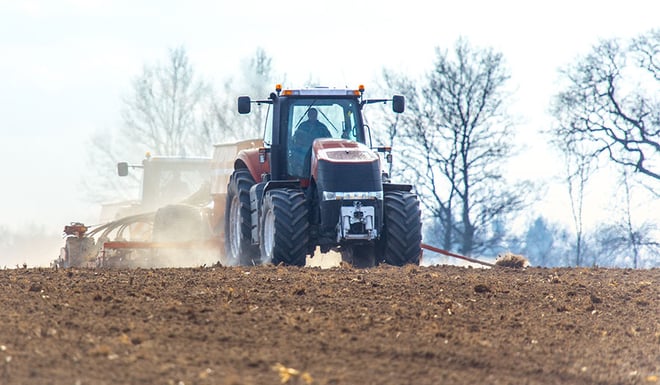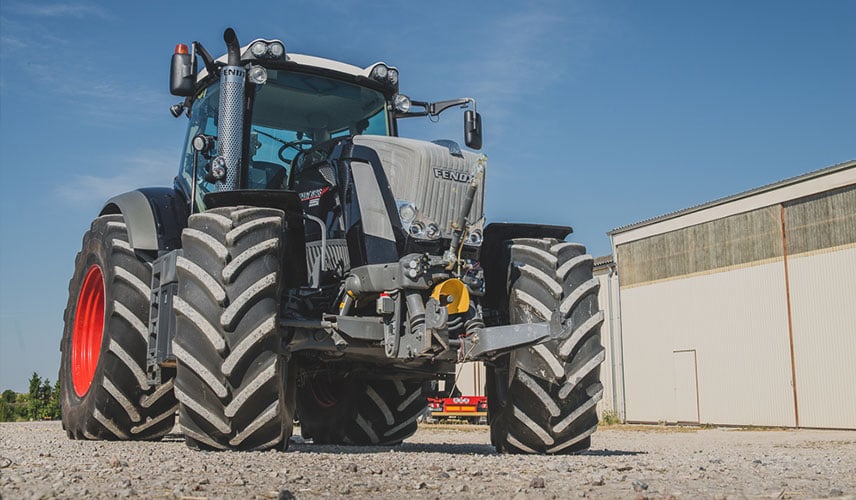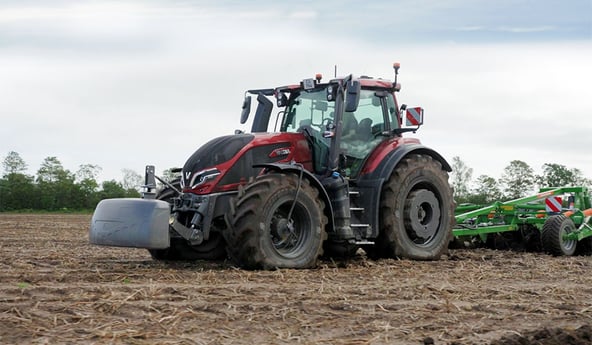While certain factors such as the climate or the weight of your tractor are beyond your control, soil preservation on the other hand is something you can more or less manage, if you decide to work at low pressure. This is a good way of improving your yields.
However, to do this you will need to take into account certain limits which are linked to the characteristics of your tyres.
As the main role of inflation pressure is to compensate for the weight of your machine, you cannot decrease the pressure just for the sake of soil preservation without taking account of all the other factors: such as load, your tyres’ capacity limits, their technology, working speed, etc.
Working at low pressure with your agricultural tyres is perfectly possible but certain rules must be followed, for which you will find explanations in this article:
1. What are the 5 possible consequences linked to underinflated tyres?
Considerably reducing the pressure in the tyres increases their soil footprint and limits soil compaction in your fields. However, each agricultural tyre has its own technical characteristics which must be taken into account at all costs when working at low pressure. Depending on your tyre model, your load and the type of soil on which you are driving, you must be careful not to reduce pressure too much to avoid irreversible consequences which may cost you dearly:
1. Reducing the tyre’s lifespan by around 25%
Driving at low pressure on the road with tyres that were not designed for this purpose will cause the tyres to wear rapidly. When the pressure is too low, the rubber in the tyre heats up and becomes softer, causing rapid wear to the tread which is in contact with the highly abrasive asphalt. The tyre’s lifespan will be reduced by 25% or more if you drive on the road at high speed on a regular basis.
2. Increase in fuel consumption
On the road, an underinflated tyre’s rolling resistance is much greater than normal, causing excess fuel consumption, which increases even more if you drive long distances.
3. Reduced stability when braking, turning and on sloping land
An underinflated tyre’s stress resistance is very low. On the road, the load transfer caused by your trailer going round a bend or braking will crush your tyres, especially if you are driving with a heavy load and at speed. The load transfer will have the same effect in the fields if you are working on sloping land.
4. Irreversible damage to the casing
A frequently underinflated tyre incurs too much flexion in the sidewalls, the reinforcement strip and casing ply will wear progressively on the edge of the rim until this results in the tyre breaking just above the bead, making your tyre unfit for use.
Problem at the level of the bead
linked to frequent driving with underinflated tyres
5. Sudden puncture and halt in operations
By opting for pressure below the recommended level, your tyre may suffer internal damage which has consequences even after the pressure has been properly adjusted. A mere branch, root or stone can cause a sudden puncture, immobilising your machine with the resulting heavy financial consequences.
2. Can you trust the inflation pressure charts that start with a pressure of 0.6 bar?
Most manufacturers’ tyre pressure charts have a first air pressure level that is extremely low for many tyre models. When you want to preserve your soil, the natural reflex is to choose this type of minimum pressure for light work and continue over the entire piece of land.
Be careful, this type of chart gives you all the possible pressure settings with extreme minimum and maximum levels possible for a given tyre model, but does not advise you to work continuously at the tyre’s lowest or highest limit.
As a comparative example, a small car destined for city driving is attributed a top speed of 185km/hour by the manufacturer. It’s obvious if you drive for a whole day at this constant speed that you will damage the engine. The same applies to your tyres.
You often see recommended pressure charts that start at 0.6 bar, for a given load and speed, which is the absolute minimum for standard tyres. To avoid compacting your soil while preserving your tyres, it is better to work at a pressure of just above 1 bar or 1.2 bar and not at the very limit indicated in the manufacturer’s table (0.6 bar). It is effectively possible to reduce pressure to 0.6 bar to work on a part of your land with a more difficult soil, such as loose soil or very wet ground, but only for short distances, at very low speed and working in a straight line on flat surfaces.
3. What are the factors which prevent you from working at low pressure?
The purpose of working at low pressure is to preserve the soil, but it cannot be done without respecting several technical parameters, such as load, type of soil, steep slopes, working speed and tyre technology.
Pressure is directly linked to load
Pressure has a direct impact on soil compaction, but its principal role is to compensate for the load represented by your tractor and its implements. The pressure cannot be the same when you are driving with or without a load. When you transport heavy loads, the casing, sidewalls and tread of the tyre are placed under great strain resulting in considerable deformation which can damage the tyre if the inflation pressure is not high enough.
Take the load transfer into account when working on a slope
Pressure settings are important when you work on sloping land, because the load transfer linked to the gradient of the land can result in the load capacity of a tyre or axle being exceeded by far.
When the tractor drives up the slope, there is no weight at all on the front axle while the rear axle bears the load transfer. Inversely, the full weight of the combination vehicle will push down on the front axle when the tractor drives down the slope.
If you work at low pressure, this load transfer will result in your tyres being crushed because there is not enough pressure in them to resist. If your land is not flat, to avoid having an accident, you must take all the precautions necessary and adjust your pressure settings based on load calculations taking account of the slope of the land. Adapting pressure must take priority over soil care in order to preserve your tyres.
Pressure settings are important
when you work on sloping land
Pressure and speed are directly linked. If you work at low pressure with standard tyres, this is incompatible with high speed.
At low pressure, the tyre flattens out massively on the ground, and it recovers its original form when it lifts off the ground with each rotation. If the speed is too high, it doesn’t have time to recover its initial form in the space of one wheel rotation and will deform further. The accumulation of these deformations increases the temperature within the tyre, weakens the rubber and the internal structure and can result in the tyre bursting.
4. Which tyre models are designed to work at very low pressure?
There are agricultural tyre models which have been designed to work at very low pressure, such as VF (Very high Flexion) technology tyres. The construction of their casing is highly specific, it has been reinforced and its multi-layer structure gives it a greater flexion capacity. Its sidewalls are more supple but at the same time more solid than those of standard tyres.
Robustness and time saving
In the fields, these high-tech tyres can drive at very low pressure without any risk of damage. The casing of a VF tyre can, for example, manage a pressure of 0.6 bar in normal working conditions whereas a standard tyre should stay above 1 bar. Furthermore, the VF tyre has been developed to go from one type of soil to another without changing the pressure, so that you save precious time during your working day.
Load and pressure comparison: standard vs VF tyre
The more robust structure of VF tyres give them a greater load capacity compared to standard agricultural tyres. You therefore have the choice with this technology of increasing the load without increasing inflation pressure or decreasing pressure for the same load as a standard tyre.
VF VT-TRACTOR tyres
Here is an example of comparison between standard and VF tyres used in the fields at a speed of 10 km/h:
Tyre dimensions: 650/85 R38 for a load of 7,000 kg:
- The standard tyre should be inflated to 2.2 bar
- The VF VT-TRACTOR tyre may be inflated to 1.4 bar
- Difference of – 0.8 bar for the VF tyre
Tyre dimensions: 600/65 R28 for a load of 4,000 kg:
- The standard tyre should be inflated to 2.2 bar
- The VF VT-TRACTOR tyre may be inflated to 1.4 bar
- Difference of – 0.8 bar for the VF tyre
These VF tyres allow you to either increase the load by 35 to 40% or to reduce pressure to 0.6 bar for the same work load as a standard agricultural tyre.
The Bridgestone-agriculture.eu blog is written and administered by tractor tyre experts who are available to provide you with the advice that you need about your farming tyres. They will help you to maximise your productivity with information on all things relating to tyres: inexpensive tractor tyres - technical data for farming tyres - advice on farming tyre pressure - solution to avoid soil compaction - sprayer tyre pressure - Why and how to ballast your tractor tyres - when to use twin wheels - the mechanical causes of abnormal wear - cheap agricultural tyres - etc.
To take it a step further and increase the profitability of your farm, the tractor tyre experts has prepared a free, highly detailed, ebook which explains the essential role of farming tyres on your productivity.
Most people who read this article have also read some of the following articles:
- 12 simple tips to better manage the pressure of your agricultural tyres
- No, adjusting the pressure of your tractor tyres is not optional
- How can I be sure that my agricultural tyres are always at the right pressure?
- Pressure: it’s the volume of air in the tractor tyre that counts
- Non-adjusted tyre pressure will lead to damage to my tyres
- How much does it cost you not to adjust the pressure of your agricultural tyres?
- How to get rid of the tractor tyre pressure adjustment step
- Farming tyres, pressure monitoring or full Central Tyre Inflation System CTIS
- 7 advantages of low-pressure tyres compared to normal tyres
- What is the right inflation pressure for any tractor tyre
This information is intended only to make you aware of the technical and functional aspects of agricultural tires and their use. It does not allow you to make a judgment or a definitive conclusion on a given problem. Only your agricultural tire expert is able to make a technical assessment and take a final decision, case by case.
Leave a
commentary
Your email address will not be published.
Required fields are indicated with *











